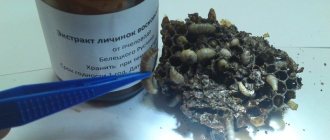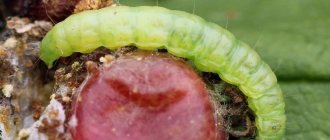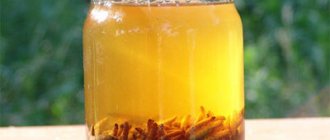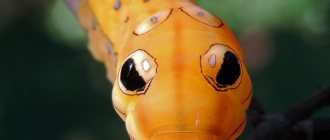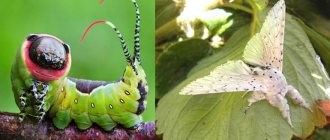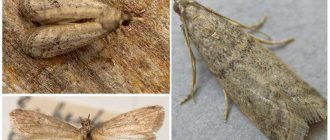Moths are perhaps the most common insect pest on earth, which causes a lot of trouble for humans. One of its varieties is moths. They belong to the Lepidoptera family, which includes more than 6,000 species of moths (the moth butterfly is pictured below). Each species has its own characteristics and taste preferences: some eat plants, others eat food, and others pose a threat to bee colonies. The surprising thing is that it is not the adults who are dangerous, but their larvae - the moth caterpillars. This article will tell you about the most common types of such pests.
Melnichnaya
The mill moth is a dark gray butterfly, measuring up to 14 mm in length. The insect was brought from India and prefers to feed on grains, flour products, nuts, mushrooms and dried fruits. Therefore, flour mills, bakeries or mills become its habitat. The lifespan of the pest is about three weeks, during which the female manages to lay about 200 eggs. Seven generations are hatched per year.
Types of moths
Among the huge number of varieties of moths, there are several that are more common than others.
Boxwood moth
The boxwood moth is a fairly large representative of the family. The span of the bluish-sandy wings of an adult butterfly reaches 4.5 cm. These pests settle on evergreen trees and systematically destroy their foliage. After the tree is left with practically bare branches, the colony moves to nearby trees or begins to eat the young bark. Gradually the boxwood dries and dies. These trees already grow slowly, and an invasion of butterflies can completely destroy an entire boxwood grove.
Mill moth
The mill moth is a medium-sized butterfly with dark gray wings, the span of which varies from 1.5 to 2.5 cm. The pest feeds on cereals, flour and flour products, nuts, and dried fruits. The main habitats are mills, flour mills, bakeries, and warehouses. In heated rooms, up to 10 generations of insects can appear in a year.
Southern barn moth
This species belongs to the barn moths. The butterflies are small, grayish-yellow. Just like the grain moth, mill moth and flour moth, it feeds on seeds, cereals, food products, and plant animal feed. The southern barn moth lives in granaries, confectionery factories, food warehouses, bakeries, and can also be found in residential buildings.
South barn
Dried fruit moth
The dried fruit moth is a sandy gray butterfly with a wingspan of up to 2.2 cm. This species of moth is found all over the world, excluding only the coldest regions. Butterflies settle in heated rooms where there is food. In addition to dried fruits, caterpillars destroy nuts, grains, confectionery products, and some types of seeds.
Bee moth or wax moth
Under the name bee moth, two subspecies are combined: small and large wax moths. These insects settle where beekeeping flourishes. Yellow-gray butterflies lay eggs in hives. The hatched larvae begin to feed on honey and beebread, and as they mature, wax honeycombs are added to their diet. Due to the invasion of pests, the hive becomes unsuitable for the life of the bee colony, and the volumes of beebread and honey are sharply reduced.
Flour moth
Another type of barn fire. A light brown butterfly, with a wingspan of up to 3 cm. The larvae of the flour moth prefer grains, cereals, seeds, baked goods and sweets. They can be found in residential buildings and apartments, in shops and warehouses, in flour mills and confectionery factories.
Gooseberry moth
The gooseberry moth is a dangerous pest of garden crops. Gray-brown butterflies can be seen circling over the bushes of red and black currants, raspberries, and gooseberries. Having overwintered in a cocoon hidden in the top layer of soil, with the arrival of warmer weather, the moth butterfly emerges and lays eggs in flower buds on currant or gooseberry bushes. The hatched larvae eat the seeds and pulp of the fruit, crawling from berry to berry. If measures are not taken, the appearance of moth on gooseberries can lead to the loss of the entire crop.
Cone moth
A gray-brown butterfly with patterns on its wings with a wingspan of 2.4–3 cm is most often found in coniferous forests. This type of moth damages cones on pine, spruce, fir, and cedar trees. In a lean year, pine moth caterpillars can switch to young shoots and blossoming buds.
Acacia moth
Acacia moth is also called legume moth. This insect with gray-blue wings affects not only white and yellow acacia, but also such crops as:
- beans;
- peas;
- lentils;
- lupine;
- alfalfa;
- clover.
Acacia
In total, the pest’s diet includes about 80 species of cultivated and wild plants. Plants are infected in the fields, and then the caterpillars, along with the harvested crop, move to storage facilities and there they undergo the last stage of development.
Cruciferous scorched moth
Small straw-yellow butterflies mainly attack plants from the cruciferous family, namely:
- all types of cabbage;
- turnip;
- radish;
- rape;
- mustard;
- radish;
- horseradish.
Two generations appear over the summer. Moreover, the second survives the winter in the ground in the form of a pupa.
Cabbage moth
This yellowish-gray butterfly with a brown pattern on its wings is familiar to many gardeners. The larvae appear in early summer and begin to eat young leaves of cabbage, horseradish and sugar beets. At first, the caterpillars only scrape off the lower surface of the leaf, but as they grow older they can gnaw right through the leaf. If measures are not taken in time, pests can destroy the entire crop.
Gooseberry
The gooseberry moth is a harmful and dangerous pest of gooseberries and currants. Insects spend the winter in the ground in the state of pupae. With the arrival of warm days, moth butterflies emerge from them and lay eggs in flower buds. The hatched moth caterpillars feed on the pulp and seeds of the resulting fruits. Having thus destroyed the first ovary, the caterpillars crawl through a hole gnawed on the side onto a nearby growing berry. After 5-6 days, using a similar method, the caterpillars move to the next berry, entangling the bunch with a thin web.
Description and life cycle
An adult moth is a butterfly with a wingspan from 1 to 4.5 cm (depending on the species). Some tropical moths grow much larger, with a wingspan reaching 8 - 8.5 cm. Butterflies have a thin body, long legs, and two pairs of wings. The upper wings are narrow, in the form of an elongated triangle. The lower ones are wide, rounded, with fringe along the edge. The head has bulging eyes, antennae and a mouth organ in the form of a proboscis. The proboscis in many species is shortened, and in some it is not at all. Adults do not feed, and their vital activity is supported by substances accumulated during the larval stage.
The vast majority of moths are inconspicuously colored in all shades of gray or brown. These species are mainly active at dusk and in the dark. But there are also brightly colored moths. They are not afraid of sunlight and fly during the day.
Appearance of a mill fire
The life cycle of the true moth consists of 4 stages. After mating, the female lays eggs. After 7–10 days, larvae emerge from the eggs. The caterpillars, which look like small light worms, are actively feeding and growing. After 10–35 days, the larva sinks into the soil, where it pupates. The development of a butterfly inside a pupa usually takes from 10 to 25 days, but some species overwinter in a cocoon and emerge when the weather warms. An adult butterfly lives 1 – 3 weeks. During this time, the female manages to lay from 70 to 150 (sometimes up to 200) eggs.
Wax
The wax moth is known to a wide range of beekeepers. Its caterpillars are a dangerous pest of honeycombs. They damage not only honeycombs, but also honey, brood and bee bread. As a result, the frames and insulation of the hives are damaged, and this in turn leads to the death of bee colonies.
Moth moth
Interesting!
However, the insect also has a positive side: since ancient times, moth caterpillars have been used in folk medicine to prepare medicinal tinctures. This drug has antiviral and antibacterial effects, improves metabolism, strengthens the immune and nervous systems.
Control measures
The basic rule of combating any type of moth is to detect it in a timely manner and correctly identify it. There are 3 main ways to destroy harmful insects:
- chemical;
- mechanical;
- biological.
Treatment with insecticides is the most effective, but also the most undesirable method. Chemicals will indeed quickly destroy butterflies and larvae, but they can also harm beneficial insects, and in addition, after using toxic drugs, it is not always possible to eat crops and products. Also, not everyone is ready to use toxic substances at home. Therefore, insecticides are recommended for use in cases of severe infestation or when other means have failed.
The mechanical method is absolutely safe, but requires a lot of time and patience. You need to manually collect and destroy caterpillars and butterflies.
The biological method allows you to get rid of moths both with the help of biological products and with the involvement of natural enemies of these pests. Among them are birds, lizards, frogs, and some types of predatory insects. You can also use folk remedies.
To get rid of pests as quickly as possible, several methods are combined.
Signs of defeat
The moth in its natural environment feeds exclusively on boxwood, so it poses the greatest danger to this crop.
The main signs of the appearance of a pest:
- a cobweb appears on green leaves and shoots, in which you can find the shell of larvae, metabolic products of caterpillars, and dry parts of pupae;
- the plant quickly dries out and becomes weak;
- on the leaves you can find a large number of yellow-green caterpillars covered with small fibers;
- the ground within the radius of the tree crown emits an unpleasant odor caused by the presence of butterfly excrement.
Signs of damage are extremely characteristic, so detecting the moth is not particularly difficult. Unlike spider mite infestation, a large number of pupae and caterpillars can be found on the tree and in the immediate distance from it.
What harm does an insect cause to plants?
The boxwood moth causes enormous damage to boxwood trees. The life activity of the pest is closely related to this plant, since its leaves are the main source of food for the insect. As a result of moths settling in boxwood groves, the plants begin to rapidly dry out, deteriorate and even die.
By gnawing a significant amount of tree foliage, the insect destroys the integrity of the crown. Because of this, the plant’s nutrient metabolism processes are disrupted and a serious failure in photosynthesis occurs.
This factor also adversely affects other crops growing in the same area as boxwood.
The dynamics of the insect population, as well as the harm it causes, depends on many factors: food
base, intraspecific and interspecific interactions, environmental conditions. Thus, the boxwood moth, brought to the territory of the Krasnodar Territory, found itself in a very favorable environment with extensive nutritional resources, good weather conditions and the absence of individuals eating it. This led to the fact that stable, strong forests, which had been in a calm, healthy state for more than a thousand years, were seriously damaged in the shortest possible time. Today, the infestation of the boxwood moth in the Kuban territory is a serious threat to the unique yew-boxwood grove, which can be completely destroyed.
In addition, this individual can cause the complete disappearance of evergreen boxwood throughout the North Caucasus.
The presence of boxwood moth in plant crops can be determined by the following characteristics:
- leaves and shoots are densely covered with cobwebs, which are clogged with the skins of larvae, excrement of caterpillars and black head shells;
- the plant dries out quickly;
- a large number of dark green and yellowish-green caterpillars covered with fine hairs live on branches and foliage;
- the ground is covered with insect waste: a layer of processed greenery, feces, which emit an unpleasant specific odor.
The gamas tick is an unpleasant and dangerous parasite. Contact your doctor promptly if you come into contact with him. If you want to eliminate insects, read this useful article.
The fight against animal parasites is difficult, but it must be done. Read the following link for material that will help you.
Boxwood moth - destroys boxwood, “eats” the budget
Evergreen boxwood (Buxus sempervirens) and its varieties have been very popular for many centuries and are widely used in landscaping in Europe, both in public areas and in private gardens.
For quite a long time, boxwood, as an introduced species, has been widely used in landscaping in Ukraine. Boxwood is especially popular for creating topiary shapes - balls, cones, complex curly shapes, etc.
Literally until 2015 – 2021, there were no particular problems with growing boxwood in Ukraine. Sometimes, in early spring, it could burn in the sun; in very cold winters, annual shoots could freeze. Of the pests, it could be “attacked” by boxwood copperhead and scale insects; in unfavorable years, fungal diseases could appear. It was clear how to deal with these “misfortunes” and they, as a rule, did not lead to the complete death of plants.
But 3-4 years ago, a “deadly” pest of evergreen boxwood appeared in Ukraine - the boxwood moth or boxwood moth (lat. Cydalima perspectalis (=Diaphania perspectalis), an invasive species of butterflies from the family of grass moths (Crambidae).
Boxwood bushes damaged by boxwood moth, Kiev, 2021
In Europe, the boxwood moth was first discovered in 2006 in Germany and in subsequent years it quickly began to spread throughout Europe. In 2007, this type of pest became an environmental problem in European countries such as the Netherlands and Switzerland. For this reason, the moth has been listed as a particularly dangerous pest species (EPPO Alert List). From Turkey, the moth entered Georgia, where it was first identified in the Batumi region in 2012. The species was then found in Slovakia, Belgium and Croatia.
In 2012, this dangerous pest was brought to Sochi during the preparation of the 2014 Winter Olympic Games along with evergreen boxwood seedlings. The result of the widespread distribution of the moth was the almost complete destruction of the relict Colchian boxwood in the Caucasus.
In 2015, the species was discovered in boxwood plantings in a number of places in Crimea, and then its “march” began throughout our country.
Dead boxwood bushes after they were damaged by the boxwood moth, Kyiv, 2021
What does the pest look like and how to detect it.
Like most gnawing pests, the boxwood moth goes through the following stages of development: butterfly - egg - caterpillar - pupa (cocoon) - butterfly.
An adult butterfly has light blue wings with a brown edge (see photo). After mating, females lay eggs about 1 mm in diameter on the underside of boxwood leaves. The length of the greenish-yellow caterpillars (larvae) emerging from the eggs is only 1-2 mm. The development of caterpillars, and therefore nutrition, lasts about a month. By the end of their development, the caterpillars reach a length of 35-40 mm, become dark green in color with wide black and several thin white stripes on the sides of the body, as well as a number of large convex black dots (see photo)
Boxwood moth butterfly
Adult boxwood moth caterpillars
The pupa is 25-30 mm long, located in a cocoon between boxwood leaves. As a rule, pests spend the winter in the pupal stage. True, recent studies have shown that in the south of the country the boxwood moth can overwinter in the caterpillar stage.
Boxwood moth pupa
The first sign that this dangerous pest has appeared on the boxwood is the presence of a thin white web with which the caterpillars cover the bush, a change in the color of the leaves to whitish, as well as damaged, gnawed leaves. In case of massive damage to boxwood, a large number of dark green and yellowish-green caterpillars covered with fine hairs are clearly visible on the branches and foliage. At this time, near the bushes you can feel an unpleasant odor that comes from the waste products of the caterpillars (excrement).
Boxwood leaves damaged by boxwood moth caterpillars
How dangerous is the pest?
This pest is simply distinguished by its colossal “gluttony”! It can “purely” eat boxwood leaves, and this happens with great speed - with a strong infestation, the caterpillars are able to destroy boxwood bushes in a matter of days.
Young larvae feed only on the lower surfaces of leaves and leave the upper epidermis intact, while older larval stages (adult caterpillars) chew not only leaves, but can also eat the green bark of young twigs.
A boxwood bush after significant damage by the boxwood moth cannot be restored
If you do not take urgent measures to combat the pest, the boxwood bush quickly acquires a brown color, which subsequently leads to its drying out and death. If the bushes are severely damaged by the caterpillars of the boxwood moth, it is practically impossible to restore the boxwood bushes.
Some experts note that when the usual food (boxwood) is no longer nearby, the boxwood moth can damage maple, euonymus and other types of plants
Pests reproduce very actively. In Ukraine, the pest can produce 3 generations. Under particularly favorable climatic conditions, identical to the conditions of the natural habitat, the 4th generation is also possible.
Are there effective methods of pest control?
Since the pest is quite “new” for the conditions of Ukraine, there is not yet a unified approach to combating it.
Some, having discovered a moth on boxwood bushes, carry out deep pruning of the branches and then burn them. Some gardeners decide to get rid of boxwood bushes on their site altogether. Others use a chemical control method, spraying the bushes with special preparations. In this case, the question is often asked, which insecticides are most effective in controlling the boxwood moth?
Experts and practitioners on forums, in articles, in seminars, in master classes and videos name a variety of drugs that have proven to be quite effective in the fight against boxwood moth in the 2021 season. The most commonly called drugs are Probrand, Decis pro, Actellik, Ampligo, Enzhio, Nurel D, Confidor maxi, Aktara, etc.
Drugs such as Match and Lepidocid have performed well against younger caterpillars.
But, alas, there is no single recipe for effective control of boxwood moth. After all, it is very important to take into account the stages of development of the pest, the frequency of treatments, the required concentrations of the drug, the application rates of the drug, etc., etc.
With such a degree of infection of the bushes, effective control of the boxwood moth is possible. The bush can be saved.
The only thing on which the opinions of all experts agree is that it is very important not to miss the appearance of the boxwood moth and to start fighting it in a timely manner. And, if it was already noticed last season, then with the beginning of the new season, in the conditions of Ukraine - in April, preventive treatments should be carried out without waiting for signs of infection to appear.
Therefore, if the boxwood moth appears on boxwood bushes (for their timely detection, the boxwood should be inspected from April to October), it is better to contact specialists, because only an experienced specialist will be able to correctly select an effective chemical preparation, calculate the dose of the preparation, thereby protecting both your plants from death, and yourself from possible poisoning with chemicals, because many of them are very toxic.
How can a boxwood moth eat up your budget?
Even in garden plots where there is boxwood, this pest can cause significant material damage. Indeed, if boxwoods are not processed in a timely manner, their death is possible, and, therefore, it will have to be replaced with new specimens of boxwoods or other types of plants (you can read the author’s article on the portal about an alternative to boxwood - “Is there an alternative to boxwood?” This, in turn, can lead to monetary costs for the purchase of plants, transportation and planting.
Such costs can be especially large at large public facilities - parks, squares, arboretums, and especially in historical parks.
In May 2021, the author visited the wonderful park at the Schönborn Palace in Transcarpathia (Mukachevo district, Karpaty village). Directly in front of the palace, a fairly large amount of boxwood was planted, which is already quite impressive in age and size.
Alas, the destructive effects of the boxwood moth in 2021 were already visible on many bushes (see photo).
The author saw an even more “terrible” picture in the historical Odessa park “Dyukovsky Garden” in October 2021.
In the central part of the park, a lot of evergreen boxwood was planted and, practically, not a single living bush remained; all the bushes were eaten by the caterpillars of the boxwood moth.
Hedges of evergreen boxwood in the Dyukovsky Garden park before infection with the boxwood moth (photo from the Internet)
The same evergreen boxwood hedges in the Dyukovsky Garden park after infection with the boxwood moth and lack of control in 2021 (photo by the author, October 2021)
And since in parks that have the status of a park-monument of landscape gardening art, it is necessary to preserve the historical layout and assortment of plants, there will be a need to completely replace the dead boxwood with a new one, which will entail significant financial expenses incommensurate with the costs of chemical treatment of boxwood to preserve it from damage by boxwood moth.
To restore 100 meters of single-row hedge, 500 pieces are needed. boxwood In order for the hedge to have a decorative appearance in the year of planting, it is necessary to plant boxwood with a height of at least 30-40 cm. Its cost in the spring of 2019 in garden centers in Ukraine was about 50 - 60 UAH / bush. Accordingly, only the cost of planting material to restore 100 meters of hedge will be 25-30 thousand hryvnia, another 10-15 thousand hryvnia will need to be spent on planting, that is, to restore only 100 meters of hedge you will need to spend at least 35-45 thousand. UAH But in the park there are hundreds of meters of dead hedges! At the same time, the cost of 3-5 times chemical treatment of 100 meters of hedge against pests would cost only a few hundred hryvnia.
Although these calculations are not absolutely accurate, they clearly show the importance and economic feasibility of timely protection of ornamental plants from dangerous pests.
Petr Rekovets – dendrologist, chairman of the board of the Kyiv Landscape Club
Why is it dangerous?
Butterflies and caterpillars pose a huge threat to boxwood trees. They actively devour the green parts of the plant. The caterpillar can destroy one leaf in just 4 days. During the same period, 20 larvae can eat a 3-liter jar filled with boxwood.
If there is a lack of food, insects switch to other deciduous ornamental plants - larch, holly, euonymus, medlar and others. Cases are described when the moth also affected fruit trees, which is explained by the lack of usual food in the immediate vicinity.
If treatment is not carried out in time, within just one season the moth population can completely consume a small grove of boxwood; the plants subsequently recover poorly and quickly die.
History of infection
In 2002, large quantities of planting material were brought from the East, namely from China, India, Japan and Korea, to Germany. This became the starting point for the mass reproduction of dangerous insects in Europe. This problem began to grow on a large scale and after a very short period of time, in just a couple of years, it began to worry all European countries and turned into a real environmental problem.
In preparation for the Olympic Games, using the same planting material, the harmful butterfly was brought to Russia from Europe and other countries. The boxwood brought from Italy was affected by insect larvae, and in the shortest possible time the invasion of butterflies became the most important problem in the Krasnodar region.
Pest feeding
Both adult insects and caterpillars feed on boxwood leaves . If they are deficient, the pest moves on to the foliage of other plants or eats the bark of a boxwood tree. In Sochi, in addition to boxwood, damage was also found to such crops as Colchis larch, cherry laurel, maple, ash and Japanese medlar.
Moth caterpillars are very voracious - in 4 hours one individual eats a medium-sized boxwood leaf. 20 individuals process a 3-liter container tightly filled with boxwood leaves in 2 hours.
What does it look like?
Photo:
The box moth or box moth is a harmful species of butterfly belonging to the family of grass moths. It poses a huge danger to boxwood plantings.
Home to the Far East of Russia and Asian countries, since 2006, the butterfly has actively spread throughout the Western Hemisphere, including Denmark and New Zealand. The pest entered the territory of western Russia during preparations for the Winter Olympics in Sochi.
The adult specimen is represented by a large butterfly, the wingspan of which can reach 45 mm. The eyes are very large, painted in a rich dark color. The wings are slightly rounded, arranged in a fan-like manner, with segmentation. Their color is usually light blue with brown edging.
Adult butterflies have very fine hairs in the form of a fringe on their wings. The insect has long antennae, the labial tentacles are slightly pushed forward, forming something similar to the shape of a beak.
The larvae are yellow-green in color, the average length is 1-2 mm. They have a pronounced black head. The larva develops within a month, during which it can grow up to 4 cm. Gradually the color becomes darker, black and white lines form on the sides. At the same time, small dark dots with a characteristic bulge appear.

